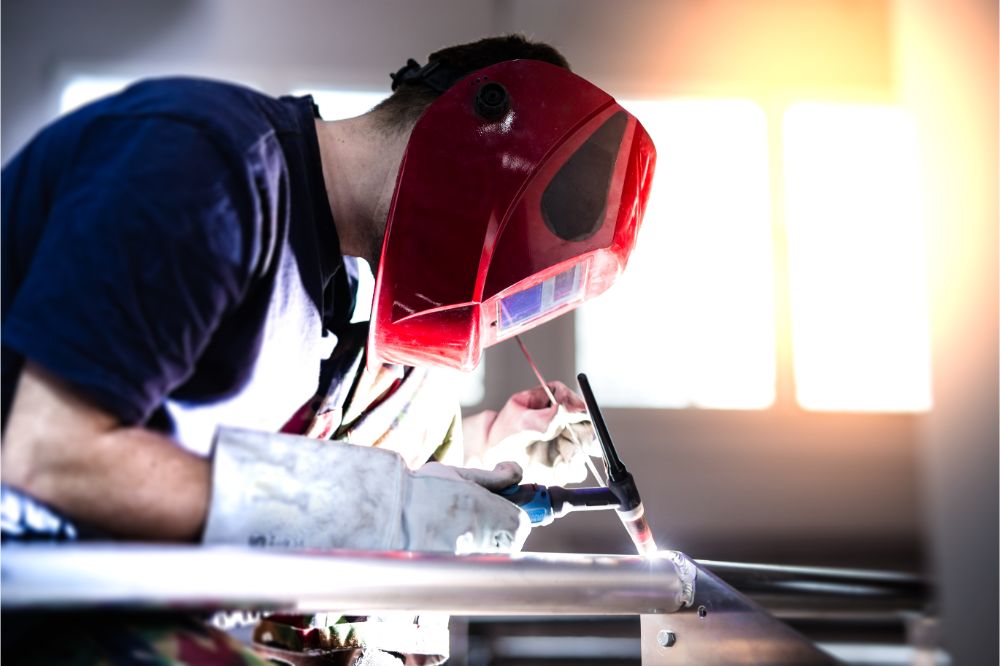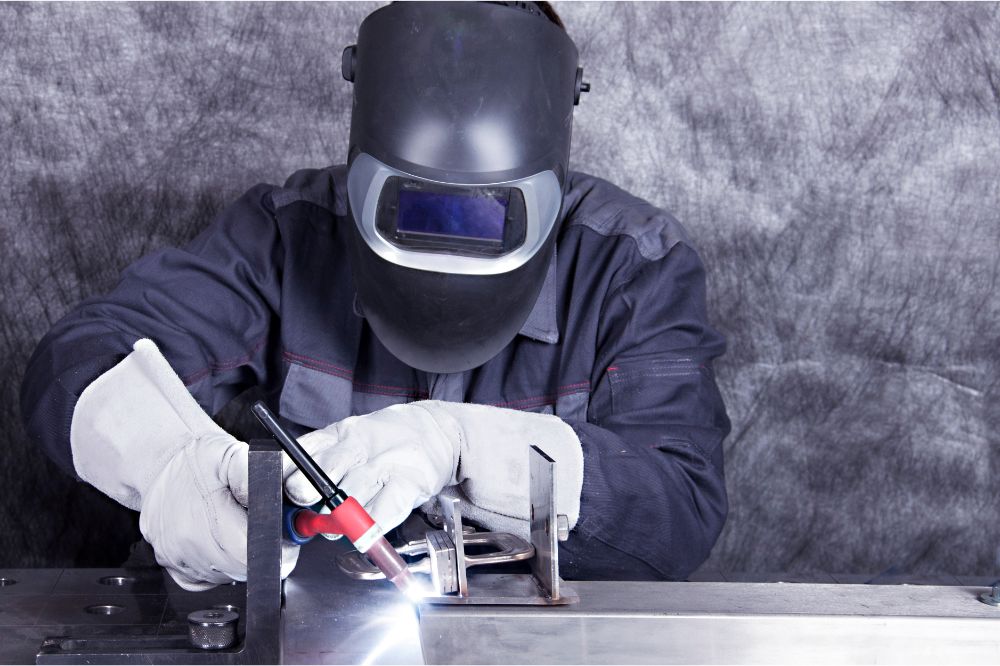Welding uses two main techniques: Tungsten Inert Gas, referred to as TIG, and Metal Inert Gas, better known as MIG. Each of these processes involves varying techniques, and the results are also different in terms of how clean the finish is. Therefore, knowing how they work is essential in determining which method is the most suitable for your work.
Similarities Between TIG and MIG Welding
Both processes share some similarities. For starters, an electric arc is produced between the electrode and the material to melt the metal. Next, a filler material is added to combine the metal pieces being welded together. For a more refined finish, you should ensure you clean the surfaces of the metals you want to weld. Brush off any debris or dirt particles as they can stain the final form of the welded metal.
These two welding techniques also involve heating the metals until they become liquid-like. A filler material is then used to join the two. However, this process is a bit different.
With TIG welding, an electric current is passed through a tungsten electrode which melts the metal. A filler is then manually added to the puddle to join the two pieces. The current is controlled using a foot pedal.
During TIG welding, you will use both hands, where one will supply the filler metal while your other hand holds the torch. However, filler materials aren’t necessary for all TIG welding processes. Moreover, unlike arc welds, TIG welding doesn’t produce splatter allowing for a cleaner finish.
Compared to the TIG, the MIG welding process is much more common and widely used as it is easier and faster to learn. In MIG welding, a metallic wire is connected to an electrode and uses short-circuit welding. One of the upsides of MIG welding is that it saves you the trouble of having to coordinate multiple processes simultaneously. The filler addition is done automatically during the heating process. Moreover, once the puddle is formed, the gun automatically releases the inert gas to prevent any reaction of the liquified metal with atmospheric elements.
Differences Between TIG and MIG Welding Techniques
TIG and MIG welding each have their upsides and drawbacks, depending on the situation. When considering which method will best serve you, we recommend assessing your type of project and what the expected outcome is. It will help if you consider things like your welding experience and the materials you want to work with.
Below are highlights of the differences between these two welding processes.
- Difficulty – TIG is arguably a more difficult process to learn. Your hands will be busy with a torch in one hand and the filler material in the other. Additionally, you will need to regulate the current using the pedal. This triad requires a professional who has experience dealing with welding. MIG is a simpler process that gets the job done by combining the melting, filler, and gassing processes in one hand.
- Technique – When going with TIG, you must operate a torch with one hand and feed separate filler material to the weld. When it comes to MIG, the wire electrode is fed through the spool gun to make the weld.
- Type of metal being used – MIG welding is typically used with mild steel, stainless steel, aluminum, and most other metals. For TIG, it is recommended that you use them with thinner gauge metals.
- The thickness of the object – With MIG, you can weld thicker metals much faster than TIG welding. When welding thinner metals, we recommend going for TIG.
- Speed – Although TIG is slower, it provides incredible details. MIG, on the other hand, is faster, making it perfect for projects that need high production rates.
- Size of the project – TIG is better if you work with thin metals and on small projects as they are precise and offer a clean finish. MIG works best on thick metals that require long continuous runs for larger projects.
- Equipment – Both processes have equipment that is made differently. TIG and MIG welds come with unique components and designs that make them perfect for their jobs.
- Control – MIG is easier to control. It makes it easier for beginners, whereas TIG welders are required to have more experience.
- Appearance – For clean and beautiful finishes, go for TIG welding. It is most preferred because of its attractive appearance and is used for ornamental and artistic purposes.
- Cost – Regarding expenses, TIG is more expensive than MIG welding.
TIG and MIG Welding Components
Since these processes approach welding differently, the equipment will differ to accommodate the changes. Below are some component comparisons of the TIG weld and the MIG weld.
Components of the TIG Weld
The following are the main components used in TIG welding:
- Power – TIG welding uses both DC and AC. Some welders install a switch that allows them to select their desired current choice. This is because metals such as aluminum are best welded using AC. DC power sources on the other hand offer a strong arc but the metal pieces should be thoroughly cleaned first so the inert gas shield works properly.
- Torch – Unlike MIG torches, TIG torches come in various designs with some featuring an on and off button on the handle.
- Foot pedal – The harder you push the foot pedal, the more the electrical current is increased, thus making the arc hotter. However, you should ensure you are conversant and familiar with handling the extra speed and heat.
- Filler material – The filler rods vary in terms of material and size. Just make sure that the rod matches whatever material you are welding.
- Backing bars – These cool the torch much faster than letting it cool on its own. They can be made of aluminum or copper. These bars are clamped at the back of the welding piece to disperse heat. There are also water-cooled backing bars that circulate cold water to cool the torch.
Components of a MIG Weld
- Power – MIG welds use DC power sources with consistent voltage.
- Electrode – Here, you need to put your project into consideration. Depending on the project, you must get your MIG weld’s diameter and composition right.
- Wire – For your wielding to be even, its wire-feed system must run smoothly. By feeding systems, we refer to pinch-rolls, spool-on-gun, and push-pull.
- Torch – A MIG torch does two main things: it passes current to the wire and provides the inert gas. To cool the torches, you can use water-cooled and air-cooled methods. However, most people tend to lean towards air-cooled ones because they are much cheaper and lighter. These are perfect for lighter welding projects. Water-cooled guns are best used for heavy-duty projects.
- Filler material – In a MIG weld, the filler material is the one that conducts the electrical current and also reinforces the welded pieces of metal together.
- Gas shielding – MIG welding uses carbon dioxide or Argon for this.
- Conduit – For the feeding to happen seamlessly, the conduits should be short and straight.

Pros and Cons of These Two Types of Welding
TIG Welding
Pros
- It offers more precision and higher quality welds.
- It involves a much cleaner process that is more environmentally friendly.
- It does not need a filler metal.
- It has greater control as the foot pedals can adjust the heat input.
- It requires less maintenance. The electrodes do not need much upkeep.
Cons
- Welding costs are higher as compared to that of MIG because the process is much slower and due to low deposition rates.
- The welding surface should consistently and regularly be clean.
- The preparation and welding processes take much longer.
- It requires experienced operators.
MIG Welding
Pros
- The welds are created within a much shorter time.
- It is cheaper than TIG welding.
- Getting accurate bonds with MIG is easier.
- It needs little post-weld maintenance.
Cons
- It is weaker than TIG welding.
- There are reliability issues due to wire burn-back and arc stability.
- Heavy smokes and fumes are produced.
- Sometimes it leads to the formation of rust deposits.
- Using this method requires thick metal as you can quickly burn through the metallic pieces being welded.
- It has specific requirements for gases and wires.
Conclusion
Knowing when to go for TIG or MIG welding is very important and makes all the difference in taking your projects a notch higher in terms of the quality of your welding results. For example, we recommend TIG welding when:
- Welding thinner metals
- You have good and reliable hand-eye coordination
- Welding appropriate metals
- Taking on artistic or ornamental projects
On the other hand, go for MIG when you’re welding thicker material, you want smoother fewer defects, or need to weld for long hours.

